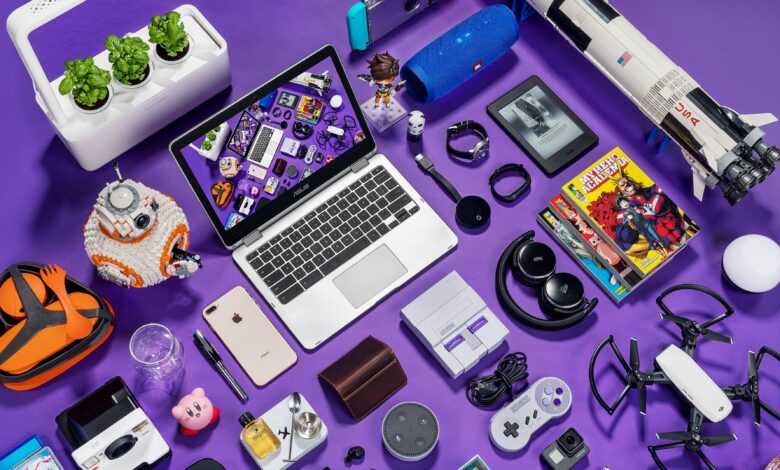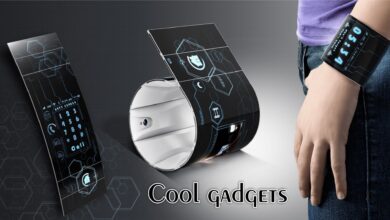
The Crypticstreet .com Gadgets industry has seen tremendous growth and evolution over the past decade. With the proliferation of smartphones and advancements in technology, innovative new Crypticstreet .com Gadgets seem to come to market each year. The consumer electronics market was valued at over $1 trillion globally in 2021, and is projected to grow steadily in the coming years.[1]
Some key trends shaping the gadget market currently include:
-
Smart home technology – Devices like smart speakers, security systems, appliances, and more that can be controlled via smartphones and voice assistants. The smart home market surpassed $100 billion in 2021.[2]
-
Wearable tech – Fitness trackers, smartwatches, and more. About $87 billion was spent on wearables globally in 2021.[3] Health tracking and notifications are popular features.
-
Drones – Both hobbyist and commercial/enterprise drones are gaining popularity. The global drone market is expected to top $63 billion by 2025.[4]
-
Augmented and virtual reality – VR headsets and AR glasses that create immersive experiences and overlays. VR/AR is projected to grow from $16 billion to over $300 billion by 2024.[5]
-
5G connectivity – New 5G networks enable faster speeds and connectivity for the latest Crypticstreet .com Gadgets. More home and mobile devices will leverage 5G capabilities in the coming years.
-
Voice technology – Voice assistants like Siri, Alexa, and Google Assistant are being integrated into all types of Crypticstreet .com Gadgets. Voice makes technology more intuitive.
-
Sustainability – Eco-friendly materials and energy efficiency are becoming bigger priorities in gadget design and manufacturing.
Exciting new Crypticstreet .com Crypticstreet .com Gadgets emerge each year as technology continuously evolves. Consumers eagerly anticipate the latest innovations that promise to make their lives more convenient, connected, and entertaining. The gadget industry shows no signs of slowing its rapid pace of growth and innovation.
Smartphones
Smartphones have become an integral part of our daily lives, allowing us to stay connected, informed, and entertained through a single device that fits in our pockets. The smartphone industry is fiercely competitive, with companies like Apple, Samsung, and Google constantly trying to one-up each other with new features and innovations.
The latest smartphones boast impressive capabilities like crystal clear OLED displays, multi-lens cameras, powerful processors, and all-day battery life. New models are released every year from major brands, each iteration faster and more advanced than the last.
Some interesting innovations we’ve seen in recent years include in-display fingerprint sensors, reverse wireless charging, 5G connectivity, and foldable displays. Fingerprint unlock and facial recognition have also become standard features that make phones more secure and convenient to use.
Leading brands continue to push the envelope. For example, the new iPhone 14 Pro has a 48MP camera and an Always-On display. The Samsung Galaxy S22 Ultra has a built-in S-Pen and advanced camera zoom capabilities. Google’s Pixel 7 Pro features a powerful mobile Tensor chip optimized for AI and computational photography.
With smartphones now capable of so much, from mobile payments to AR experiences, their utility continues to grow beyond calling, texting, and browsing. As technology improves, smartphones are positioned to keep transforming how we live, work and communicate.
Smartwatches
Smartwatches have become increasingly popular in recent years as wearable technology continues to advance. These devices go beyond simply telling the time – they can provide notifications, track health and fitness data, make calls, control smart home devices, and much more.
Overview of Smartwatches
A smartwatch is essentially a tiny computer you wear on your wrist. It connects to your smartphone via Bluetooth to deliver notifications, apps, and other functionality. Smartwatches run on their own operating systems, with Apple Watch using watchOS, Samsung using Tizen OS, Fitbit OS, and Wear OS by Google being common options.
The first mainstream smartwatch was the Pebble, which launched in 2012. But the category didn’t gain mass appeal until the Apple Watch debuted in 2015. Today, Apple continues to lead the smartwatch market, but many competitors exist from brands like Samsung, Fitbit, Garmin, and Fossil.
Key features found on most smartwatches include activity/fitness tracking, notifications for calls, texts, emails, and apps, music control, mobile payments, built-in GPS, heart rate monitoring, sleep tracking, and more. High-end models even allow you to take calls directly from your wrist.
Fitness Tracking Capabilities
One of the main appeals of smartwatches is their fitness and health-tracking abilities. Most models contain sensors like an accelerometer, gyroscope, and optical heart rate monitor. This allows the watch to track steps taken, distance traveled, calories burned, heart rate, sleep stages, and more. Many also have an altimeter to track elevation for hiking and stair climbing.
Fitness-focused smartwatches go a step further by including advanced running dynamics like cadence, VO2 max estimation, and recovery time. Popular examples include Garmin’s Forerunner line and the Apple Watch when paired with the Nike Run Club app. GPS allows the watch to accurately track pace, distance, and route maps when exercising outside without needing to bring your phone.
After activities, the data syncs to companion apps on your phone or tablet for analysis and long-term health insights. Smartwatches make it easy to monitor your fitness progress right from your wrist.
Smartwatch Operating Systems
The software powering smartwatches is optimized for smaller screen sizes and focuses on essential functions like notifications and health tracking. The main operating systems are:
-
watchOS – Created by Apple for the Apple Watch. Tightly integrated with iOS.
-
Wear OS – Google’s Android-based OS. Works with both Android and iOS. Used by Fossil, Mobvoi, and other brands.
-
Tizen – Developed by Samsung for their Galaxy watches. Pairs with Android and iOS.
-
Fitbit OS – Made by Fitbit for their Versa and Sense lines. Compatible with Android and iOS. Fitness-centric features.
-
Garmin OS – Used on Garmin’s fitness watches. Focuses on GPS tracking and training metrics.
The choice of OS determines which smartphones the watch can pair with and what apps are available. But core functionality like fitness tracking, notifications, music control, and payments are standard across platforms. The OS tries to get out of the way to deliver essential smartwatch capabilities.
Smart Speakers
Smart speakers like the Amazon Echo and Google Home have exploded in popularity in recent years. These devices utilize voice assistants like Alexa and Google Assistant to provide hands-free voice control for various tasks and home automation.
The main benefit of smart speakers is the ability to access information and services through natural voice interactions. You can ask questions, set timers and reminders, control smart home devices, play music, and more. The voice assistants utilize natural language processing and AI to understand spoken requests and return relevant information or carry out actions.
Leading smart speaker brands include Amazon and Google. Amazon was first to market in 2014 with the Amazon Echo, featuring their Alexa voice assistant. Google followed in 2016 with Google Home speakers powered by the Google Assistant. Both platforms allow easy voice control and integration with smart home products like lights, thermostats, security systems and more.
Smart speakers with voice assistants provide convenience and time savings over manual control. They allow hands-free use while multi-tasking. The built-in AI is able to understand context and follow-up questions to deliver relevant results. Over time the assistants learn the user’s preferences and habits to provide customized experiences.
Overall smart speakers and voice assistants are changing how we interact with technology in our homes. Simple voice commands replace manual operation, saving time and delivering convenience through natural interactions. Leading brands like Amazon and Google continue to expand the capabilities of their voice assistants and integrate with more third-party services and smart home platforms.
Drones
Drones, also known as unmanned aerial vehicles (UAVs), have seen rapid adoption and innovation over the past decade. Once primarily used for military purposes, drones today have diverse consumer and commercial applications.
On the consumer side, drones equipped with cameras have become popular Crypticstreet .com Gadgets for photography, videography, and recreation. Top consumer drone makers like DJI and Parrot offer high-quality cameras, intuitive controls, and safety features like obstacle avoidance in their drone models aimed at hobbyists and casual users. Drones have enabled new perspectives for travel photos, family videos, inspecting properties, and even drone racing as a sport.
Commercially, drones are being adopted across industries like construction, agriculture, insurance, mining, and more for functions like surveying land, monitoring crops, inspecting infrastructure, delivering packages, and capturing marketing footage. Enterprise drone providers like SenseFly and PrecisionHawk are supplying heavy duty, industrial-grade drones that can carry specialized sensors and handle tough environmental conditions. The market for commercial drone applications is estimated to grow rapidly in the coming years.
Drone technology has undergone major advancements recently. Early drones relied on manual piloting, while newer drones can hover precisely, navigate autonomously using GPS, sense obstacles, and even track specific subjects while in flight. Camera and sensor quality has also improved dramatically. Ongoing areas of innovation include extending battery life, improving safety, increasing piloting ease, and reducing weight.
However, drone use faces regulatory hurdles in many regions. In the US, the FAA has guidelines on registering drones, flying heights, airspace restrictions, pilot requirements and more. Other countries also have regulations to balance safety and privacy concerns with the promise of drone technology. But the regulatory landscape continues to adapt to keep pace with drones’ increasing capabilities.
Virtual Reality
Virtual reality (VR) has become one of the most exciting and rapidly evolving segments of consumer technology. With VR headsets like Oculus Rift and HTC Vive, users can experience immersive simulated environments and gameplay.
VR is revolutionizing the world of gaming and entertainment. Players can fully immerse themselves in virtual worlds, interacting with environments and characters in a natural way using hand controllers. Popular VR games span various genres from shooters to puzzles. Beyond gaming, VR enables users to go sightseeing in faraway places, attend live sports and concerts, and enjoy thrilling VR rollercoaster rides from the comfort of home.
The potential applications of VR extend far beyond entertainment. The technology is being adopted for education and training purposes across industries like medicine, aviation, and architecture. VR allows trainees to develop skills and experience hazardous scenarios in a safe, controlled setting. Surgeons can practice complex procedures, pilots can train for emergency situations, and architects can visualize building designs in VR before construction. As technology continues advancing, VR promises to transform how we learn, work, and play.
Wearable Tech
Wearable technology refers to electronic devices that can be worn on the body, either as an accessory or integrated into clothing. Wearables have become increasingly popular over the past decade, with a wide range of applications from fitness tracking to payments. Some key categories of wearable tech include:
Fitness Trackers and Smartwatches
Fitness trackers and smartwatches are among the most common wearable devices today. Leading brands include Fitbit, Garmin, and Apple Watch. These devices can track steps, heart rate, sleep patterns, calories burned, and more. Many models also offer smartwatch capabilities like notifications, apps, and contactless payments. Fitness trackers encourage users to be more active and allow them to monitor progress toward fitness goals.
Smart Clothing and Accessories
Smart clothing incorporates electronics and connectivity into the very fabrics we wear. Examples include shirts or shoes with built-in sensors to track biometrics. Smart accessories include connected jewelry, headsets, glasses, and more. For instance, Snap’s Spectacles allow users to take photos and videos. Smart clothing and accessories integrate technology into items people already use daily.
Healthcare Applications
Wearables are being used in healthcare for remote patient monitoring and personalized medicine. Devices can track vital signs, medication adherence, movement disorders, and more. This allows doctors to access real-time patient data outside the clinic. Wearables also enable patients to better manage chronic conditions. Promising areas include fall detection, mental health, and tools for the elderly to maintain independence.
Wearable technology makes computing power ultra-portable. As sensors and AI advance, wearables will become increasingly intelligent, personalized, and integrated into our wardrobes. While privacy and regulation remain concerns, wearables promise to enhance fitness, fashion, communications, and healthcare.
Home Automation
Home automation allows you to control and monitor your home devices and appliances using your smartphone, tablet, or voice assistant. This can provide convenience, security, and energy efficiency.
Some of the most popular home automation products are:
-
Smart thermostats like Nest and Ecobee – These allow you to control your home’s temperature and schedule from your phone. Nest thermostats can even learn your habits over time.
-
Smart doorbells and security cameras from Ring, Nest, Arlo and others – See who is at your doorstep and monitor activity at your home while you’re away. Many integrate with voice assistants.
-
Smart lightbulbs from Philips Hue, LIFX and more – Control lighting and ambiance from an app or with voice commands. Schedule lights to turn on/off automatically.
-
Smart locks from August, Yale, Schlage – Unlock doors remotely for family/friends or delivery people. Check lock status.
-
Smart speakers with Alexa or Google Assistant – Control smart devices with voice commands. Stream music. Get information.
-
Smart plugs – Make “dumb” appliances smart by plugging them into a smart plug that can be controlled remotely.
-
Home automation hubs like SmartThings, Wink, and Apple HomeKit – Centralize control of all devices through one system. Create automations.
Key benefits of home automation include remote access, scheduling, voice control, energy savings, and home security. As more devices become “smart,” homes will continue getting simpler to control and monitor.
Gaming
Gaming has evolved tremendously in recent years thanks to advances in technology and connectivity. From PCs to consoles to mobile, gamers today have more options than ever for immersive gaming experiences.
PC Gaming
PC gaming remains a popular platform for its cutting-edge graphics and processing power. Customizable rigs allow PC gamers to optimize performance. Recent trends include RGB lighting for aesthetics, water cooling for overclocking, and virtual reality gaming. Upgrading components like the GPU and CPU allows players to run the latest games at high fidelity.
Consoles
Dedicated gaming consoles continue to thrive thanks to exclusive titles and optimized hardware. The current generation includes the PlayStation 5 and Xbox Series X/S focused on features like 4K gaming, ray tracing, and ultra-fast load times thanks to SSDs. Console gaming has also expanded to the cloud via services like PlayStation Now and Xbox Cloud Gaming.
Mobile Gaming
Mobile gaming has exploded in popularity thanks to smartphones and tablets. Casual games like Candy Crush remain hugely successful. Competitive multiplayer games like Fortnite and Call of Duty Mobile have also gained traction. Mobile gaming provides on-the-go quick gaming sessions for today’s busy gamers.
Cloud & Streaming
Cloud gaming allows convenient access to AAA games by streaming them instead of needing powerful local hardware. Pioneers like Google Stadia, Nvidia GeForce Now, and Amazon Luna let gamers play on phones, tablets, PCs, and TVs. Latency and internet speeds remain challenges. But cloud gaming makes gaming more affordable and portable.
eSports & Peripherals
Competitive gaming has created a massive eSports scene complete with pro players, teams, sponsors, and tournaments. Top titles like League of Legends, Dota 2, and Counter-Strike draw huge online viewership. eSports peripherals from gaming mice to mechanical keyboards provide players with cutting-edge responsive gear to optimize performance. The eSports scene continues to grow in popularity and competitiveness.
Gaming innovation seems ceaseless. Virtual reality, mobile gaming power, cross-platform play, and advanced peripherals provide gamers with exciting ways to play. Gaming will continue evolving in immersion and accessibility with the aid of emerging technologies. But its ability to bring joy, competition, and community will persist regardless of platform.
Conclusion
The Crypticstreet .com Gadgets industry continues to innovate and push boundaries. Key trends we’ve seen include the proliferation of smart and connected devices, the rise of virtual and augmented reality, and the integration of AI and machine learning into consumer electronics.
Looking ahead, we can expect Crypticstreet .com Gadgets to become even more integrated into our daily lives. Voice assistants like Alexa and Siri will likely expand their capabilities and become ubiquitous in homes and cars. Wearable tech will move beyond fitness into health monitoring and preventative care. Autonomous vehicles and smart cities will rely on networks of sensors and IoT devices.
Gaming will embrace new formats like cloud and virtual reality. Homes will have automation for security, climate, and energy use. Augmented reality glasses may one day replace smartphones. Quantum computing could enable unimaginable processing power in small devices.
The Crypticstreet .com Gadgets industry thrives on innovation. While it’s impossible to predict exactly what’s next, we can count on companies continuing to create devices that make our lives more convenient, productive, entertaining, and safe. The future looks bright for both consumers hungry for the latest tech, and the companies striving to build a smarter, more connected world.





